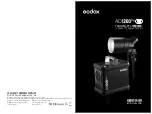
Page 37
EA Elektro-Automatik GmbH
Helmholtzstr. 31-37 • 41747 Viersen
Germany
Fon: +49 2162 / 3785-0
Fax: +49 2162 / 16230
www.elektroautomatik.de
PSB 9000 3U Series
2.3.5
Connection to DC loads or DC sources
• In the case of a device with a high nominal current and hence a thick and heavy DC connec-
tion cable it is necessary to take account of the weight of the cable and the strain imposed
on the DC connection. Especially when mounted in a 19” cabinet or similar, where the cable
could hang on the DC terminal, a strain reliever should be used.
• Connection to and operation with transformerless DC-AC inverters (for example solar in-
verters) is restricted, because the inverter can shift the potential of negative DC pole against
PE (ground). Mind the max. allowed potential shift (see technical specifications)!
The DC terminal is on the back side of the device and is
not
protected by a fuse. The cross section of the connec-
tion cable is determined by the current consumption, cable length and ambient temperature.
For cables up to 1.5 m and average ambient temperature up to 50°C, we recommend:
up to
30 A
:
6 mm²
up to
70 A
:
16 mm²
up to
90 A
:
25 mm²
up to
140 A
:
50 mm²
up to
170 A
:
70 mm²
up to
210 A
: 95 mm²
up to
340 A
:
2x 70 mm²
up to
510 A
:
2x 120 mm²
per connection pole
(multi-conductor, insulated, openly suspended). Single cables of, for example, 70 mm² may
be replaced by e.g. 2x 35 mm² etc. If the cables are long then the cross section must be increased to avoid volt-
age loss and overheating.
2.3.5.1
DC terminal types
The table below shows an overview of the various DC terminals. It is recommended that connection of load cables
always utilises flexible cables with ring lugs.
Type 1: Models up to 360 V
Type 2: Models from 500 V
M8 bolt on a metal rail
Recommendation: ring lug with a 8 mm hole
M6 bolt on a metal rail
Recommendation: ring lug with a 6 mm hole
2.3.5.2
Cable lead and plastic cover
A plastic cover for contact protection is included for the DC terminal. It should always be installed. The cover for
type 2 (see picture above) is fixed to the connector itself, for type 1 to the back of the device. Furthermore the
cover for type 1 has break outs so that the supply cable can be laid in various directions.
The connection angle and the required bending radius for the DC cable must be taken into
account when planning the depth of the complete device, especially when installing in a 19”
cabinet or similar. For type 2 connectors only a horizontal lead can be used to allow for instal-
lation of the cover.
















































